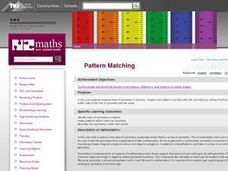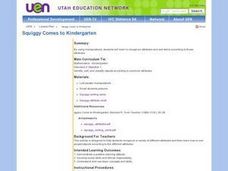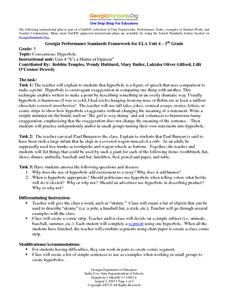Curated OER
What Do Parts Do?
Learners review the components of the scientific inquiry method. In groups, they identify and describe the components and functions of all of the parts of a plant. Using a diagram, they label the parts of the plant chosen and share...
Curated OER
Pattern Makers
Students are introduced to the notion of a repeating pattern. This is done by a number of means including the use of everyday objects. They are encouraged to create, describe and continue patterns.
Curated OER
Pattern Matching
First graders examine how to determine the lines of symmetry in pictures, shapes, and patterns by completing the lessons in this unit. They make patterns that show a line of symmetry and describe it using their own language.
Curated OER
Math: Sorting by Attributes
Students draw their version of a Squiggy following teacher modeling. They describe their Squiggies in a partner or small group setting and choose an attribute for a class Squiggy sort. Students discuss attributes of people and different...
Curated OER
Sundials: Keeping Time Like Native Americans
Students explore the use of sundials. They observe the shadows cast by the sun and record the times at various points throughout the day. They create sundials and record the location of the shadows and the time of day. They view a...
Curated OER
Our Solar System
Third graders describe the composition of our solar system. They recognize the names of the planets in our solar system and compare and contrast the nine planets that orbit the sun.
Curated OER
How Does It Feel?
Young scholars identify the textures of materials in their environments in order to expand their language, math, sensory, and observational skills. In this sensory activity lesson, students first write a list of different words to...
Curated OER
Improving sentences
In this improving sentences worksheet, students improve sentences by adding in verbs to describe the object of the sentence. Students improve 6 sentences.
Curated OER
Adjective Clauses: Where / Which
In this adjective clauses practice worksheet, students respond to 5 questions that require them to identify and fix adjective clause errors. Students also finish 4 sentence starters with adjective clauses and use adjective clauses to...
Curated OER
Physics: Electricity and Magnetism
Pupils draw series and parallel electrical circuits. In this electromagnet lesson, students describe how current changes depend on circuit components. Pupils use an OHT of a series and parallel circuit to predict the path of...
Curated OER
Methods of Mystery
Students utilize the scientific method to discover the age of an item. For this historical dating lesson, students compare and contrast a 400 year old cabinet to one made within a few years by using carbon dating. Students...
Curated OER
Conventions: Hyperbole
Fifth graders discuss hyperbole. In this language arts instructional activity, 5th graders understand that hyperbole enables writers to make a point by describing something in an overly dramatic way. Students create a list of objects...
Curated OER
Kinetic Theory
Young scholars describe how molecules of the different phases of matter move according to the Kinetic Theory. In this chemistry lesson, students observe and participate in teacher demos. They give real world applications of the kinetic...
Curated OER
Clouds
Second graders construct the 3 types of clouds using cotton balls and write sentences describing them. In this clouds lesson plan, 2nd graders describe a cumulus, stratus, and cirrus cloud.
Curated OER
Stone Fox Plot Frame
Fifth graders recall the major plot points of a chapter book. After reading the chapter book "Stone Fox," they students describe the plot framework through use of a worksheet. Students are then divided into group to act out selected...
Curated OER
Representing and Extending Patterns
Students explore repeating and growing patterns. In this patterns lesson, students describe patterns, explore changing patterns and match patterns. Students participate in online activities and read books that show patterns in...
Pennsylvania Department of Education
Geoboards
Learners describe shapes to their classmates using specific properties and practice making triangles on geoboards. In this geoboards lesson plan, students use string on the geoboards.
Curated OER
How Does a Satellite Stay in Orbit?
Students explore placing a satellite into orbit, then about forces needed to keep an object in orbit. They examine how satellites orbit in elliptical paths and about properties of ellipses. They learn Kepler's 3rd Law of Planetary Motion
Curated OER
Geo Jammin' - Day 2, Lesson 4: Sing a Song of Shapes
Students learn five songs to define and develop understanding of the attributes of two- and three-dimensional figures and the meaning of mathematical terms. They classify objects as either two- or three-dimensional, through the use of...
Curated OER
What's Your Sign? The Science Behind The Zodiac
Students investigate the concepts dealing with the motions of celestial objects, the ancient origins of the Zodiac and the science behind the Zodiac.
Curated OER
Fractions in Clay
Students represent and explain fractions as part of a set using modeling clay. They create sets of objects as specified by individual task cards.
Curated OER
Concrete Canoes
Students explore and analyze the relationship of buoyancy and displacement needed to make an object float. They examine various boat designs, then design and build clay and aluminum boats that hold a cargo of marbles.
Curated OER
Giving and Taking Directions (Middle School)
Students describe the difference between a declarative sentence and a command. They complete a diagram verbs, prepositions and numbers. They follow directions on a map and create directions of their own to another location.
Curated OER
Complete The Pattern
Learners are introduced to various geometric and numeric patterns. In groups, they work together to determine the next object or number in the pattern. They record their answers on a worksheet and create their own pattern to give to a...























